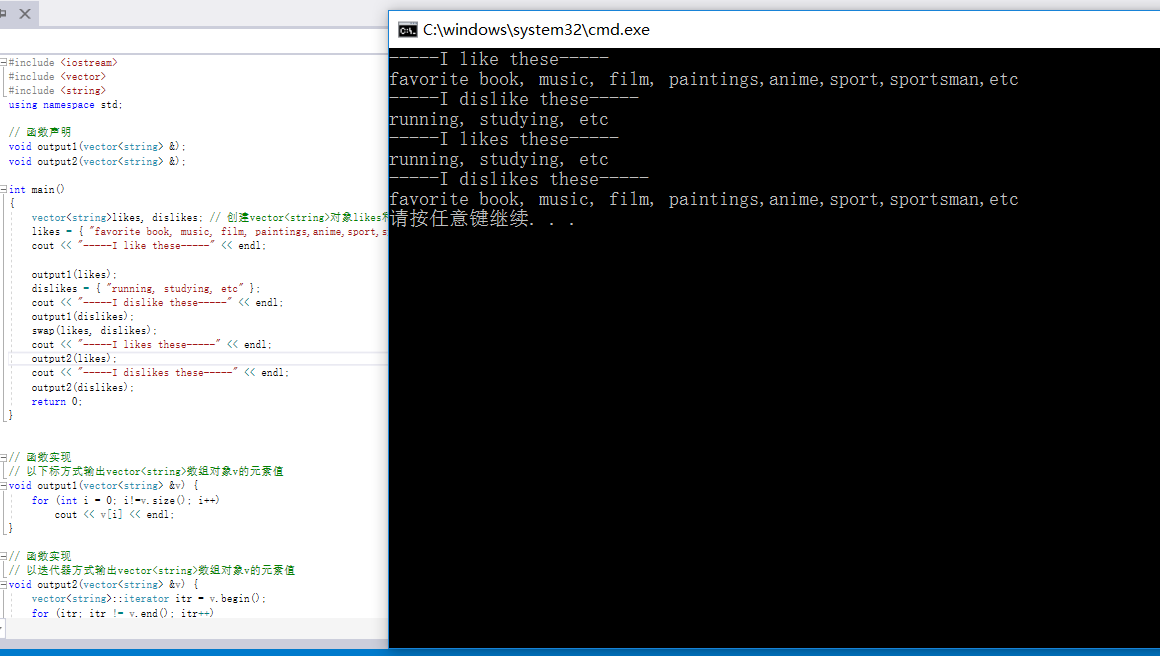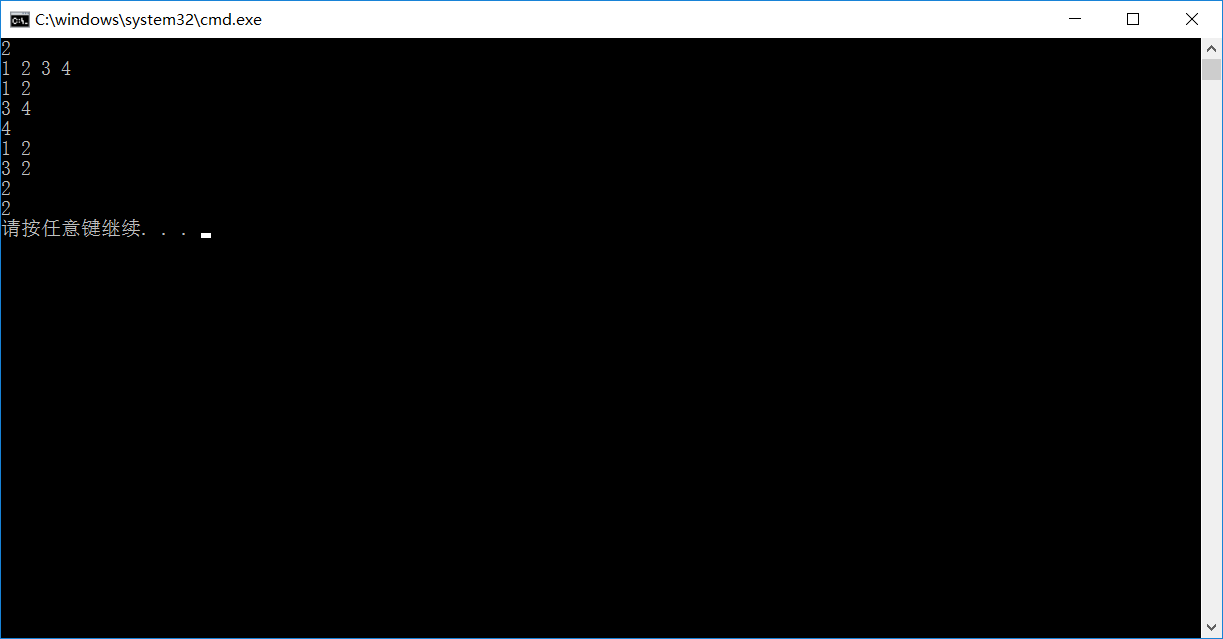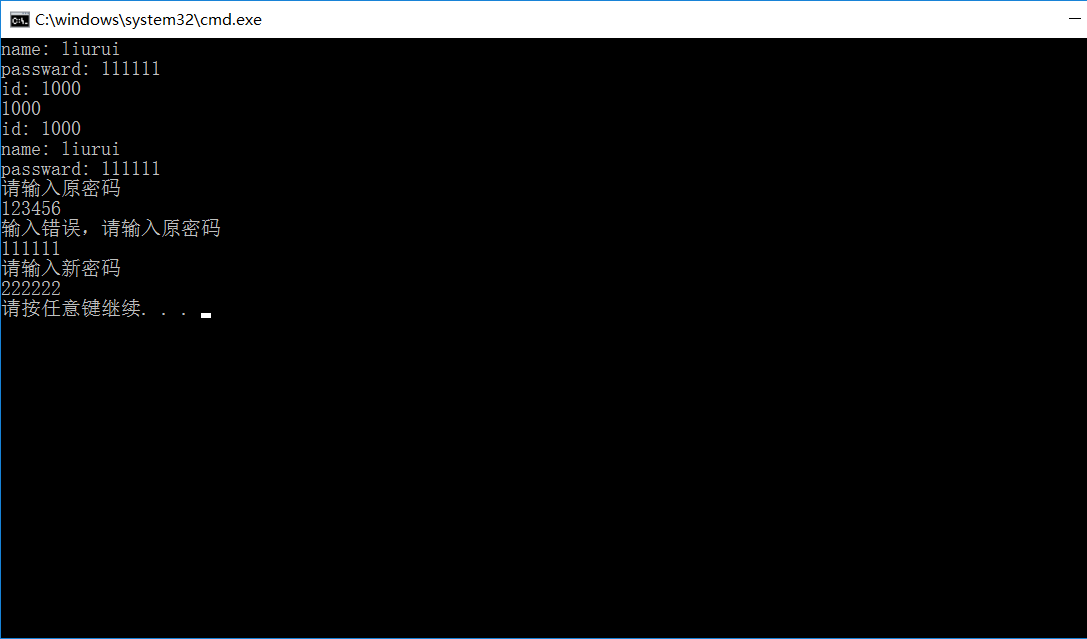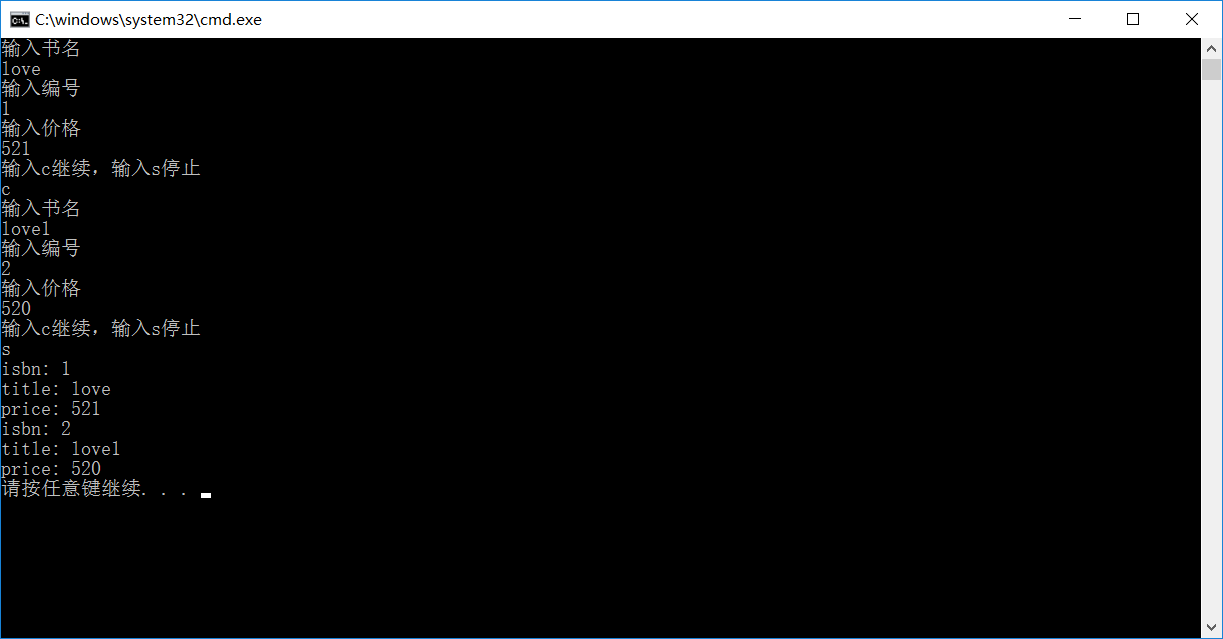#include <iostream> #include <vector> #include <string> using namespace std; // 函数声明 void output1(vector<string> &); void output2(vector<string> &); int main() { vector<string>likes, dislikes; // 创建vector<string>对象likes和dislikes likes = { "favorite book, music, film, paintings,anime,sport,sportsman,etc" }; cout << "-----I like these-----" << endl; output1(likes); dislikes = { "running, studying, etc" }; cout << "-----I dislike these-----" << endl; output1(dislikes); swap(likes, dislikes); cout << "-----I likes these-----" << endl; output2(likes); cout << "-----I dislikes these-----" << endl; output2(dislikes); return 0; } // 函数实现 // 以下标方式输出vector<string>数组对象v的元素值 void output1(vector<string> &v) { for (int i = 0; i!=v.size(); i++) cout << v[i] << endl; } // 函数实现 // 以迭代器方式输出vector<string>数组对象v的元素值 void output2(vector<string> &v) { vector<string>::iterator itr = v.begin(); for (itr; itr != v.end(); itr++) cout << *itr << endl; }

二.1.
#include<iostream> using namespace std; int main() { int *p;//指针为初始化 *p = 9;//未初始化后直接使用 cout << *p << endl; return 0; }
应该改为
#include<iostream> using namespace std; int main() { int *p=new int(9);//指针初始化 cout << *p << endl;
delete p; return 0; }
2.
#include<iostream> using namespace std; int fn1() { int *p = new int(5);//为指针p申请内存,函数中并未释放指针p的内存 return *p;// } int main() { int a = fn1(); cout << "the value of a is: " << a; return 0; }
#include<iostream> using namespace std; int fn1() { int *p = new int(5);//为指针p申请内存 delete p;//若是在此处释放,则导致没法返回指针p指向的值,程序运行出错 return *p; } int main() { int a = fn1(); cout << "the value of a is: " << a; return 0; }
所以应该改为
#include<iostream>
using namespace std;
int fn1() {
int t = 5;
int *p = &t;
return *p;
}
int main() {
int a;
a=fn1();
cout << "the value of a is: " << a;
return 0;
}
三.
class Matrix { public: Matrix(int n); // 构造函数,构造一个n*n的矩阵 Matrix(int n, int m); // 构造函数,构造一个n*m的矩阵 Matrix(const Matrix &X); // 复制构造函数,使用已有的矩阵X构造 ~Matrix(); //析构函数 void setMatrix(const float *pvalue); // 矩阵赋初值,用pvalue指向的内存块数据为矩阵赋值 void printMatrix() const; // 显示矩阵 float &element(int i, int j); //返回矩阵第i行第j列元素的引用 float element(int i, int j) const;// 返回矩阵第i行第j列元素的值 void setElement(int i, int j, int value); //设置矩阵第i行第j列元素值为value int getLines() const; //返回矩阵行数 int getCols() const; //返回矩阵列数 private: int lines; // 矩阵行数 int cols; // 矩阵列数 float *p; // 指向存放矩阵数据的内存块的首地址 };
#include "stdafx.h" #include<iostream> using namespace std; int main() { int n; cin >> n; float*pvalue = new float[n*n]; for (int i = 0; i < n*n; i++) cin >> pvalue[i]; Matrix M(n); M.setMatrix(pvalue); M.printMatrix(); cout<<M.element(2, 2)<<endl; M.setElement(2, 2, 2); M.printMatrix(); cout << M.getCols() << endl; cout << M.getLines() << endl; return 0; }
#include "stdafx.h"
#include<iostream>
using namespace std;
;
Matrix::Matrix(int n) :lines(n), cols(n) {
p = new float[n*n];
}
Matrix::Matrix(int n, int m) : lines(m), cols(n) {
p = new float[m*n];
}
Matrix::Matrix(const Matrix &X) : lines(X.lines), cols(X.cols) {
p = new float[X.lines*X.cols];
for (int i = 0; i < X.lines*X.cols; i++)
p[i] = X.p[i];
}
Matrix::~Matrix() {
delete[]p;
}
void Matrix::setMatrix(const float *pvalue) {
for (int i = 0; i < lines*cols; i++)
p[i] = pvalue[i];
}
void Matrix::printMatrix()const {
for (int i = 0; i < lines; i++)
{
for (int j = 0; j < cols; j++)
cout << p[i*cols + j] << " ";
cout << endl;
}
}
float &Matrix::element(int i, int j) {
return p[(i-1)*cols + j-1];
}
float Matrix::element(int i, int j)const {
return p[(i-1)*cols + j-1];
}
void Matrix::setElement(int i, int j, int value) {
p[(i-1)*cols + j-1] = (float)value;
}
int Matrix::getLines() const {
return lines;
}
int Matrix::getCols() const {
return cols;
}

四.期中考试第二题
#include<iostream> #include<string> using namespace std; class User { public: User(string nm,string pd="111111") { name = nm; password = pd; id = Currentid + 1; Currentid++; }; User(User&u) { name = u.name; password = u.password; id = u.id; Currentid++; }; ~User() {}; void printUser() { cout <<"name: "<< name << endl; cout <<"passward: " <<password<<endl; cout <<"id: "<<id << endl; }; void resetpassward() { int n = 3; string oldpassward; while (n) { cout<<"请输入原密码"<<endl; cin >> oldpassward; if (password.compare(oldpassward) == 0) { cout << "请输入新密码" << endl; cin >> password; break; } else cout<<"输入错误,"; n--; } }; void printCurrentid() { cout << Currentid << endl; cout << "id: "<<id << endl; cout << "name: " << name << endl; cout << "passward: "<<password<<endl; }; private: string name; string password; int id; static int Currentid; }; int User::Currentid = 999; int main() { User u1("liurui", "111111"); u1.printUser(); u1.printCurrentid(); u1.resetpassward(); return 0; }

期中考试第三题
#include<string> using namespace std; class Book { public: Book(string isbnX, string titleX,float priceX); void print(); private: string title; string isbn; float price; };
#include"book.h" #include<iostream> using namespace std; Book::Book(string isbnX, string titleX, float priceX) :isbn(isbnX), title(titleX), price(priceX) {}; void Book::print() { cout << "isbn: "<<isbn << endl; cout << "title: " << title<<endl; cout << "price: " << price << endl; };
#include<iostream> #include"book.h" #include<vector> using namespace std; int main() { vector<Book>books; string isbn, title; int price; while (true) { cout << "输入书名" << endl; cin >> title; cout << "输入编号" << endl; cin>> isbn; cout << "输入价格" << endl; cin >> price; Book book1(isbn, title, price); books.push_back(book1); cout << "输入c继续,输入s停止" << endl; char a; cin >> a; if (a == 's') break; else; }; for (int i = 0; i < books.size(); i++) books[i].print(); return 0; }
